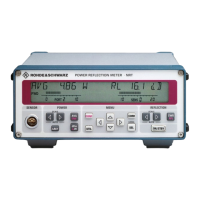Annex
NRP2
363User Manual 1173.9140.02 ─ 07
behavior: In the 1174.2 mode, they are not filtered out by the driver, but are recog-
nized by the parser like normal SCPI commands.
In this mode, the control sequences are to be terminated by <CR><LF> like SCPI com-
mands.
Table 1-6: Control sequences of the IEC/IEEE 1174 draft
Control sequence Transmitter Function
&SRQ <CR>< LF> Device Service request
&ddd <CR><LF> Device Sends STB and RQS as a three-digit decimal value ddd
(response to &POL)
&DCL <CR><LF> Device Device clear acknowledge
&LLO Controller Changes the remote-local state to local lockout
&POL Controller Conducts a serial poll (measuring instrument responds with &ddd
CR LF)
Additional Rohde & Schwarz control sequences
table 1-7
lists additional Rohde & Schwarz control sequences not defined in the IEC/
IEEE 1174 draft. The definition of these new control sequences is necessary in order
to make remote control operation via Ethernet conform to the functionality of the IEC/
IEEE 488.1 standard.
●
>M (go to mixed):
This control character changes the remote-local state to remote in the local state.
This enables the instrument to be operated simultaneously via the front panel and
via RS-232-C and Ethernet. The IEC/IEEE 1174 draft does not provide this simul-
taneous operation because the remote control state is automatically assumed
when data is received.
●
>R (go to remote):
This control character changes the remote-local state to remote. The >R com-
mand allows a change to the remote state, even before data is received. The com-
bination of the special control sequences >M and GTR allows switching over
between the remote and local states.
●
&DCL (device clear):
The IEC/IEEE 1174 draft defines that a measuring instrument must emulate the
IEC/IEEE 488.1 device clear function. In the case of RS-232-C, the device clear
active state (DCAS) is achieved when a break signal is received. In the case of
RS-232-C, a break is triggered by means of a hardware link. When remote control
is available by TCP/IP via Ethernet, there is no break signal. To nevertheless per-
mit the IEC/IEEE 488.1 device clear function, the two synonymous commands
&DCL and &BRK are newly defined.
●
&ABO (abort):
An abort corresponds to an asynchronous device clear. This becomes necessary
in order to clear a communications deadlock of link 1. If an asynchronous abort is
performed, the input and output queues will be cleared.
Remote control interfaces
北京海洋兴业科技股份有限公司(证券代码:839145)

